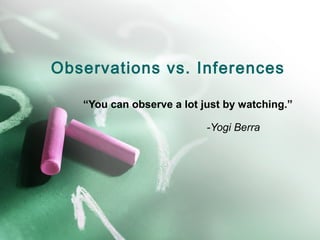3_Observations and Inferences
•Télécharger en tant que PPT, PDF•
1 j'aime•1,081 vues
Signaler
Partager
Signaler
Partager

Recommandé
Recommandé
Contenu connexe
Tendances
Tendances (20)
The scientific method and experimental design 9th grade biology

The scientific method and experimental design 9th grade biology
Similaire à 3_Observations and Inferences
Similaire à 3_Observations and Inferences (20)
Mystery footprints observationinference_9.12.12.pp

Mystery footprints observationinference_9.12.12.pp
Plus de Bantay's Earth Science!
Plus de Bantay's Earth Science! (20)
Severe Weather - Lightning, Tornadoes, & Hurricanes

Severe Weather - Lightning, Tornadoes, & Hurricanes
Earth - Sun - Moon Relationships: Annual Motions/Seasons

Earth - Sun - Moon Relationships: Annual Motions/Seasons
Dernier
Dernier (20)
DEV meet-up UiPath Document Understanding May 7 2024 Amsterdam

DEV meet-up UiPath Document Understanding May 7 2024 Amsterdam
Biography Of Angeliki Cooney | Senior Vice President Life Sciences | Albany, ...

Biography Of Angeliki Cooney | Senior Vice President Life Sciences | Albany, ...
Cloud Frontiers: A Deep Dive into Serverless Spatial Data and FME

Cloud Frontiers: A Deep Dive into Serverless Spatial Data and FME
Apidays New York 2024 - Accelerating FinTech Innovation by Vasa Krishnan, Fin...

Apidays New York 2024 - Accelerating FinTech Innovation by Vasa Krishnan, Fin...
How to Troubleshoot Apps for the Modern Connected Worker

How to Troubleshoot Apps for the Modern Connected Worker
Why Teams call analytics are critical to your entire business

Why Teams call analytics are critical to your entire business
ProductAnonymous-April2024-WinProductDiscovery-MelissaKlemke

ProductAnonymous-April2024-WinProductDiscovery-MelissaKlemke
Vector Search -An Introduction in Oracle Database 23ai.pptx

Vector Search -An Introduction in Oracle Database 23ai.pptx
TrustArc Webinar - Unlock the Power of AI-Driven Data Discovery

TrustArc Webinar - Unlock the Power of AI-Driven Data Discovery
Elevate Developer Efficiency & build GenAI Application with Amazon Q

Elevate Developer Efficiency & build GenAI Application with Amazon Q
Six Myths about Ontologies: The Basics of Formal Ontology

Six Myths about Ontologies: The Basics of Formal Ontology
Connector Corner: Accelerate revenue generation using UiPath API-centric busi...

Connector Corner: Accelerate revenue generation using UiPath API-centric busi...
Apidays New York 2024 - Passkeys: Developing APIs to enable passwordless auth...

Apidays New York 2024 - Passkeys: Developing APIs to enable passwordless auth...
Rising Above_ Dubai Floods and the Fortitude of Dubai International Airport.pdf

Rising Above_ Dubai Floods and the Fortitude of Dubai International Airport.pdf
Finding Java's Hidden Performance Traps @ DevoxxUK 2024

Finding Java's Hidden Performance Traps @ DevoxxUK 2024
3_Observations and Inferences
- 1. Observations vs. Inferences “You can observe a lot just by watching.” -Yogi Berra
- 2. Observations • An observation is the gathering of information by using our five senses: Sight Smell Hearing Taste Touch • There are two types of observations Qualitative Quantitative
- 3. A. Qualitative Observations • Qualitative observations describe what we observe. • “Qualitative” = quality (descriptive) • These observations use adjectives to describe something. • Example: The flower has white petals. • Example: Mr. M has blue eyes.
- 4. Quantitative Observations • Quantitative observations measure what we observe. • “Quantitative” = quantity (numerical) • These observations use numbers to measure something in a quantitative way. • Example: The flower has seven petals. • Example: Mr. M has two eyes.
- 5. Which is better? • Both types of observations are valuable in science. In an experiment though, quantitative observations can be precisely and objectively compared. Qualitative: The road is long. (describes) Quantitative: The road is 5 km long. (measures)
- 6. Which is better? • For example, someone might say that a dead fish is smelly. • It is hard to know just how smelly the fish is though. • To make this quantitative, the scientist could ask the person to rate the “smelliness” on a scale of 1-5. • This would then allow you to compare how smelly the fish is!
- 7. Inferences • Inferences are an explanation for an observation you have made. • They are based on your past experiences and prior knowledge. • Inferences are often changed when new observations are made. • Again, observations are information we gather directly through our five senses….inferences help explain those observations!
- 8. Here are some examples! Example 1: •Observation: The grass on the school’s front lawn is wet. •Possible inferences: It rained. The sprinkler was on. There is dew on the grass from the morning. A dog urinated on the grass! •All of these inferences could possibly explain why the grass is wet. They are all based on prior experiences. We have all seen rain, sprinklers, morning dew, and dogs going to the bathroom.
- 9. Here are some examples! Example 2: •Observation: The school fire alarm is going off. •Possible inferences: The school is on fire. We are having a fire drill. A student pulled the fire alarm. •Again, these are all logical explanations for why the fire alarm is going off.
- 10. Last one! Example 3: •Observation: A student is sitting in the main office. •Possible inferences: ? Why might a student be sitting there?
